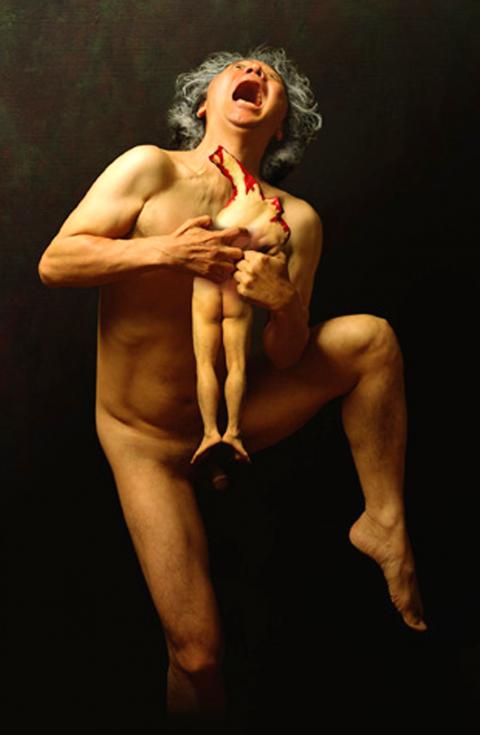The tastiest parts of the human body are the breasts and the buttocks.
So says St Jerome, the church father, in his treatise Against Jovianus, in which he describes the dietary preferences of the Attacots, a tribe living in Roman Britain.
They were, of course, not alone in eating their fellow humans. All Cannibals, an exhibition at the Maison Rouge in Paris, starts with a 1593 print depicting Brazilian women and children sitting around the severed head of a man, happily munching the rest of his body.

Photo: Bloomberg
Whether this edifying scene is a case of exo- or endocannibalism, the consumption of an enemy or a deceased relative, isn’t clear.
The title of the show, which displays works by about 30 mostly contemporary artists, is a quote from anthropologist Claude Levi-Strauss: “We are all cannibals. After all, the simplest way to identify with someone is to eat him.”
Gruesome Goya
From Brazil the show jumps forward to Francisco de Goya and the morbid symbolists Odilon Redon, Felicien Rops and James Ensor. Goya appears in different guises: Next to his Caprichos, there are prints from his Disasters of War, altered by the Chapman brothers.
Saturn Devouring His Son, one of Goya’s most gruesome canvases, has morphed into two photographs: One shows an assemblage by Vik Muniz, who recreated the painting out of junk. The other is a self-portrait by the Japanese “appropriation artist” Yasumasa Morimura, who specializes in substituting faces and bodies in famous pictures with his own.
Cannibalism, we are told, is a popular theme in contemporary Japanese art. Issei Sagawa, a mentally disturbed student who killed and ate a Dutch girl in 1981, became a celebrity after he had been found legally insane and even became a food critic.
Jeanette Zwingenberger, the curator, says in the press material that she turned down works that smacked too much of gore. In fact, even the fainthearted aren’t in danger of being overcome by twinges of nausea.
Michel Journiac’s Mass for a Body, a sacrilegious performance during which he distributed sausages made with his blood, is only visible on a video. Adriana Varejao’s painting of guts spilling out of a tiled wall looks almost abstract.
DARK HUMOR
Gilles Barbier’s photomontage displaying six clones of himself butchering each other or Renato Garza Cervera’s Genuine Contemporary Beast, the skin of a tattooed man splayed on the floor like a bearskin rug, are nice examples of black humor. (Cervera has said that he was inspired by gang wars in Los Angeles.)
Much is made of the female breast and the feeding of babies. That seems far-fetched.
On the other hand, the rich world of vampires is only mentioned in passing.
If you expect a systematic and thorough examination of a fascinating subject, you’ll be disappointed. But as an introduction, the show is worth a visit.
All Cannibals is at Maison Rouge, Paris, through May 15. On the Net: www.lamaisonrouge.org

A vaccine to fight dementia? It turns out there may already be one — shots that prevent painful shingles also appear to protect aging brains. A new study found shingles vaccination cut older adults’ risk of developing dementia over the next seven years by 20 percent. The research, published Wednesday in the journal Nature, is part of growing understanding about how many factors influence brain health as we age — and what we can do about it. “It’s a very robust finding,” said lead researcher Pascal Geldsetzer of Stanford University. And “women seem to benefit more,” important as they’re at higher risk of

Eric Finkelstein is a world record junkie. The American’s Guinness World Records include the largest flag mosaic made from table tennis balls, the longest table tennis serve and eating at the most Michelin-starred restaurants in 24 hours in New York. Many would probably share the opinion of Finkelstein’s sister when talking about his records: “You’re a lunatic.” But that’s not stopping him from his next big feat, and this time he is teaming up with his wife, Taiwanese native Jackie Cheng (鄭佳祺): visit and purchase a

April 7 to April 13 After spending over two years with the Republic of China (ROC) Army, A-Mei (阿美) boarded a ship in April 1947 bound for Taiwan. But instead of walking on board with his comrades, his roughly 5-tonne body was lifted using a cargo net. He wasn’t the only elephant; A-Lan (阿蘭) and A-Pei (阿沛) were also on board. The trio had been through hell since they’d been captured by the Japanese Army in Myanmar to transport supplies during World War II. The pachyderms were seized by the ROC New 1st Army’s 30th Division in January 1945, serving

Mother Nature gives and Mother Nature takes away. When it comes to scenic beauty, Hualien was dealt a winning hand. But one year ago today, a 7.2-magnitude earthquake wrecked the county’s number-one tourist attraction, Taroko Gorge in Taroko National Park. Then, in the second half of last year, two typhoons inflicted further damage and disruption. Not surprisingly, for Hualien’s tourist-focused businesses, the twelve months since the earthquake have been more than dismal. Among those who experienced a precipitous drop in customer count are Sofia Chiu (邱心怡) and Monica Lin (林宸伶), co-founders of Karenko Kitchen, which they describe as a space where they